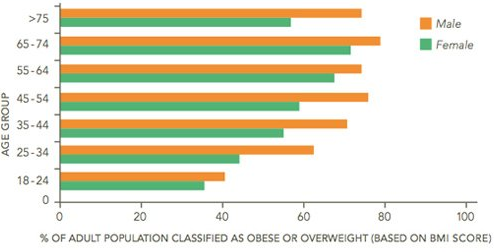About Obesity
What is Obesity?
Obesity is emerging as a health epidemic around the world.
According to the Centers for Disease Control and Prevention, obesity is rapidly spreading across all regions and demographic groups. Obesity is the second leading cause of preventable death after smoking.
Obesity is not a simple condition, it is a serious, chronic disease where your body fat has accumulated to the extent an abnormally high amount of body fat in relation to lean body mass.
Obesity occurs when an individual’s body weight is in excess of the healthy range for their height leading to a high percentage of body fat. It is a serious, chronic disease that impairs health.
Obesity is commonly measured by body mass index (BMI) and this is used to assess health risks of obesity. Your BMI calculates the relationship of weight to height. An adult with a BMI of 30 or more is considered obese.
Who is Affected by Obesity?
- 7 million Australian adults are overweight or obese,
- Over 68% of Australian adult males are either overweight or obese
- Over 55% of Australian adult females are either overweight or obese, and alarmingly
- 23% of children younger than 16 are either overweight or obese.
- Talbot ML, Jorgensen J and Loi KW. Difficulties in the provision of bariatric surgical services to the morbidly obese. Med J Aust 2005; 182: 344-47
- O'Brien PE, Brown WA and Dixon JB. Obesity, weight loss and bariatric surgery. Med J Aust 2005. 183(6); 310-314.
- World Health Organisation (WHO). Obesity and Overweight. 2006
- Australia's Health. Australian Government, Department of Health and Ageing. 2008
How Does Obesity Affect You?
- preventable, non-communicable diseases,
- shortened life-expectancy and
- impaired quality of life.
- Type 2 Diabetes,
- Coronary Heart disease,
- Hypertension or High Blood Pressure,
- Stroke,
- Musculoskeletal Disorders and Arthritis, and
- Impaired psychosocial functioning.
- Certain cancers
- Respiratory disorders
- Sleep apnea
Changing Perceptions
Before
Today
What are the Causes of Obesity?
- Energy Imbalance: Obesity happens gradually if the amount of energy or calories you consume (caloric intake) is more than the amount of energy usage on your daily activities.
- Sedentary Lifestyle: People leading an inactive or sedentary lifestyle are more likely to become obese as they do not burn down the calories they consume. Injuries causing a lack of exercise can also contribute to less movement and calorie burn.
- Environmental Factors: Lack of safe places for exercising and walking (sidewalks or parks), busy work schedule, eating larger food portions, and junk food are contributing factors to gain weight.
- Family History: The genes inherited from your parents have an effect the amount of fat stored in your body and your chances of being obese is higher if one or both your parents are obese. Obesity tends to run in families. Scientists have discovered several genes, which predispose people to obesity. These genes are the FTO, PCSK1 and ENPP1 genes. This explains why obesity often runs in families and why, for the majority of sufferers, diet and exercise alone are simply ineffective, and patients cannot seem to be able to maintain long term weight loss.
- Excessive Appetite & Overeating: It is thought that the hunger regulating part of the brain called the hypothalamus does not function correctly in people with obesity. In these people the hypothalamus continues to stimulate hunger and food desire all the time, even when your body has plenty of energy reserves. This is frequently genetic, and promotes both overeating
- Poor Diet: Poor food choices, and over time leads to obesity. Another important observation is that people who are constantly hungry often seem drawn toward foods that are rich in calories. Such foods are often high in sugar and fat, such as chocolate, fried foods, and sweets.
- Emotional Factors: Unusual eating habits such as excessive eating when under stress or anger. Overeating will cause weight gain. Comfort eating by turning to food to cope with stress, anxiety and low mood is very common. Chocolate, ice-cream, lollies and chips are usually used as they give a temporary 'hit'. Sometimes a serious or traumatic life event may trigger a person to revert back to using food to help feel better.
- Age: Ageing results in muscle loss in the body which is even more if you are inactive. Muscle loss reduces the calorie consumption and consequently uncontrolled diet may increase the chances of becoming obese.
- Disease Conditions: Hormonal disorders such as hypothyroidism, Cushing’s syndrome, and polycystic ovarian syndrome may cause weight gain.
- Medicines: Certain medicines such as corticosteroids, antidepressants and seizure medications are known to decrease the rate of metabolism, increase your appetite and retain excess water in the body leading to weight gain.
Symptoms of Obesity
- Low back pain or Backaches.
- Feeling tired all the time.
- Heavy sweating.
- Joint pain (especially weight-bearing knee and hip joints).
- Low confidence or self-esteem.
- Shortness of breath.
- Snoring or Sleep Apnoea.
Obesity Diagnosis
- Blood tests.
- Physical exam.
- Review of family history.
- Waist measurement.
Obesity Classification
- BMI Range ≥ 40, or
- BMI Range ≥ 35 combined with a high-risk co-morbid condition.
| Obesity Classification | BMI Range |
|---|---|
| Healthy Range | 18.9 to 24.9 |
| Overweight | 25 to 29.9 |
| Class I, Obesity | 30 to 34.9 |
| Class II, Serious Obesity | 35 to 39.9 |
| Class III, Severe Obesity | 40 and over |
Obesity Treatments
- Diet
- Exercise
- Medication
- Behavioural modification
- reduces overall and cause-specific mortality
- reduces obesity-related co-morbidities
- reduces medication costs
- reduces sick days
- improves QOL.
- benefits strongest in BMI>40
- 61% mean overall EWL
- greatest weight loss with LRYGB
- overall mortality < 1%
- morbidity approx. 20%
- Diabetes -77% resolved, 86% improved
- Hypertension - 62% resolved, 79% improved
- Hyperlipidemia - >70% improved
- Obstructive Sleep Apnea - 86% resolved, 84% improved
- Gastro Oesophageal reflux improved
- Urinary stress incontinence decreased by 47%New Paragraph








